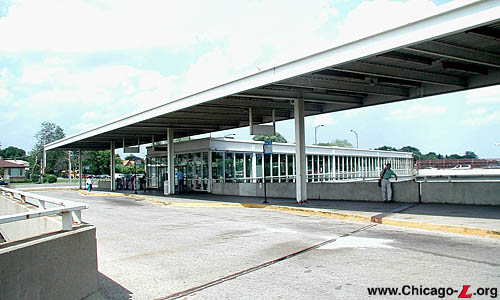
The station house for Harlem
is above and runs parallel to the Kennedy Expressway and has
two entrances: one on Harlem Avenue and one on a bus bridge,
seen here looking northeast on June 8, 2004, for intermodal
passengers. The rectilinear design of the station house
recalls the stations of the Kennedy Extension farther
southeast, also designed by the firm of Skidmore Owings
& Merrill. For a larger view, click here.
(Photo by Graham Garfield)
|
Harlem
(5600N/7200W)
Harlem Avenue and the
Kennedy Expressway, Norwood Park
Service
Notes:

|
Blue Line:
O'Hare
|

|
Accessible
Station
|

|
Park'n'Ride: 53
spaces
|

|
Owl
Service
|
Quick Facts:
Address: |
5550 N. Harlem
Avenue (station
house) |
7226 W. Higgins Avenue (bus terminal) |
Established: February 27, 1983
Original Line: West-Northwest Route, O'Hare branch
Previous Names: none
|
Skip-Stop Type:
|

|
Station
|
Rebuilt: 2016 (platform renovation, station house repainting), 2024-25 (bus bridge)
Status: In Use
History:
Harlem station was built in 1982-83 as part of the
CTA's O'Hare Extension of the
West-Northwest Route. This glass and steel station was designed by
Myron Goldsmith and the firm of Skidmore, Owings and Merrill. As a
reaction to the Kennedy and Dan Ryan extensions of 1969-70, whose
stations were all designed by Skidmore in an identical style, each of
the four stations on the O'Hare Extension were given to different
architectural firms to produce a variety of styles. Skidmore, perhaps
predictably, designed this station to harmonize with the stations it
had built immediately to the southeast on the same line 13 years
earlier.
This station contains a station house and platform, a steel bus
bridge spanning the expressway, parking and commuter drop-off areas.
The station house is over the tracks and platform, stretching between
the bus bridge and Harlem Avenue viaduct over the expressway, with
entrances from each. There are bus berthing slips on the bus bridge
over the expressway in front of the station entrance, as well as a
five-lane bus bay on the south side of the expressway with a wide
canopy covering the lanes. The same canopy extends north over a
sidewalk to the bus bridge and station entrance, allowing passengers
to transfer without stepping out from the canopy coverage. The
station house is open and airy, with a steel frame and wide, tall
glass curtain walls, and contains stainless steel fare controls.
The platform has a terrazzo floor and a canopy spanning both
tracks with a steel roof and a glass convex arched glass skylight
supported by heavy steel beams, which allows natural light to flood
the platform during the day. All the symbol signs are missing from
the outer columns and many of the station name signs are crooked due
to deteriorating metal brackets.
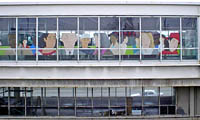
Harlem station, 1984
seen through the glass wall of the station, across the
outbound lanes of the Kennedy Expressway. There are also
images on the other side, facing the station interior. For a
larger view, click here.
(Photo by Amy
Malick)
|
As with the other two O'Hare Extension stations that opened in 1983,
the station included specially-designed artwork for the facility, an
early example of an art component being included in a transit
infrastructure project. Harlem contains a mural located inside the
station house, across from the station fare controls. The painted,
freestanding aluminum mural by internationally renowned artist Alex
Katz depicts figures in a crowd and can be viewed from both sides.
The painting celebrates Chicago's immense diversity and its
reputation as a city of hardworking people. The expansive Harlem
station is one of the largest and most complex pieces Katz has
created.
During Autumn 2004 and Spring 2005, several "L" stations got new
station name signs. As part of a multi-station program, twelve
facilities in all on the Blue, Purple, Red, Orange, and Green lines
received new, Green Line
Graphic Standard station name signs, replacing older KDR-type
signs that used an outdated graphic scheme that was inconsistent with
the colored line names. The new signs not only replaced old ones in
existing locations at these island platform stations, but were added
at additional locations outside the tracks, facing to the platform,
for ADA compliance. The new additional station name signs at Harlem
are hung off the overhead beams outside the tracks, over the jersey
barriers between the "L" right-of-way and the expressway shoulder.
Over the platforms, new overhead brackets were installed to hold new
signs there. Installation at all stations was complete by the end of November
2004. Fabrication and installation of the signs was performed by
contractor Western Remac.
In September 2004, Dunkin'
Donuts, the coffee and baked goods chain, broke ground on seven
new concessions in CTA stations around the "L" system. One such new concession was located
at Harlem station. "This is the first major concerted effort to open
a significant number of Dunkin' Donuts stores in
CTA stations," said Mike
Lavigne, director of development for Dunkin'
Donuts. All new Dunkin'
Donuts CTA station stores
were scheduled to be full-service. The new concession opened in
2005.
During the first week of August 2005, the
CTA began construction of a
new park'n'ride facility at Harlem. An additional 53 parking spaces
were constructed, including three spaces designated for customers
with disabilities, new signs, a parking pay station area, canopies to
protect customers from the elements and improved landscaping.
Construction began August 1, 2005 and lasted approximately two
months, opening Tuesday morning, November 1, 2005. Chicago-based Old
Veteran Construction, Inc. performed the construction work valued at
$75,000. The Federal Transit Administration provided funding for the
project. When the lot opened in 2005, Standard Parking Corporation
managed the new parking facility under a five-year competitively bid
agreement and parking at the new facility was $2.00 per day.
Your New Blue: Station Improvements
On December 5, 2013, Mayor Rahm Emanuel and Governor Pat Quinn announced a comprehensive improvement plan for the Blue Line O'Hare Branch (including the northern portion of the Dearborn Subway), an overhaul that will provide faster travel times and updated stations while creating more than 1,300 jobs.
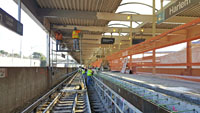
Contractors are at work at Harlem station on September 11, 2016 to renovate the platform, setting rebar to form a new concrete platform edge and repainting the canopy. The scaffold is set up during a weekend single-track. For a larger view, click here. (CTA photo) |
The $492 million plan, called Your New Blue, includes several track and station improvement projects along a 12.5-mile stretch of the Blue Line between the Grand and Cumberland stations, as well as upgrades to the signal system between the Jefferson Park and O'Hare stations. The overall Your New Blue program, beginning construction in 2014 and planned to last four years, is a package of several discrete projects ranging from station improvements to track renewal, signal replacement, traction power upgrades, and subway tunnel water mitigation efforts.
Harlem is one of 13 stations planned to receive improvements under the program, with Harlem to receive improvements more modest in scope. Addison, Irving Park, Montrose, Harlem and Cumberland stations were packaged as a group for design and construction, and all five stations had significant deterioration to their island platform decks and particularly the edges cantilevered toward the tracks. To address this, the stations received new platform edge and topping replacement. In addition, walkway railings and platform furniture such as benches, windbreaks and trash cans was rehabilitated or replaced as needed. Light fixtures were provided with new lamps and ballasts, and all five stations were repainted. The work at Harlem also included repairs to station house curtain walls, which had deteriorated in places.

Construction crews on lifts work to repair and prep the exterior steel of the Harlem station house ahead of its repainting, late on September 9, 2016. For a larger view, click here. (CTA photo) |
On March 11, 2015, the Chicago Transit Board approved the award of a $25.6 million contract to F.H. Paschen and S.N. Nielsen for the renovation of five O'Hare branch stations, including Addison. Design work began in spring 2015, with rehabilitation work at the Addison, Irving Park, Montrose, Harlem and Cumberland stations to begin in fall 2015. All stations remained open during the construction period, except for a small number of weekend-only closures at Addison and Montrose. In addition, in order to carry out the platform renewal work, each station's platform was closed half at a time, longitudinally down the middle. Trains bypassed the side of the platform being worked on, which was barricaded from passenger access to allow the deck topping to be removed and replaced. Each half-closure and bypass period lasted three weeks (except at Harlem and Cumberland, which were shorter), during which passengers had to "back-ride" (riding to the next stop, exiting and boarding a train back in the opposite direction) or use alternate existing bus or rail services. While inconvenient, the partial station closures allowed the CTA to keep the stations open for customers at all times during platform work.
Work to replace the platform decking at Harlem station commenced at 9pm, September 6, when O'Hare-bound trains began bypassing the station. This work took only two weeks (a week less than Addison, Irving Park and Montrose stations, undertaken before Harlem), followed by the Forest Park-bound side on September 20-October 4. Unlike at the other stations, where the original 1970 decking of smooth-polished terrazzo was replaced with concrete, the granite decking at Harlem was replaced in-kind.
The platform-level scope was preceded by work to repaint the station's bus terminal canopy and railings, which continued into the period in which platform work commenced.
Renovation work at Harlem was substantially completed by late Fall 2016.
Bus Bridge Replacement
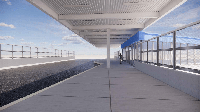
Rendering of the new bus bridge that will be constructed at the Harlem Blue Line station, looking north toward the station house. For a larger view, click here. (Image courtesy of the CTA) |
By 2024, the bridge over the Kennedy Expressway used by buses in the bus terminal on the west side of the Harlem station house had deteriorated beyond its useful life and required full replacement. The steel and concrete elevated bus bridge spans the entire width of the Kennedy Expressway and serves as a bus boarding area featuring a five-lane bus bay with canopy, as well as a commuter drop-off area.
On February 14, 2024, the CTA announced plans to replace the bridge, which required full closure of the bridge as well as the west entrance to the station house which fronts onto the bridge. The closure of the bridge and station's west entrance doors began the following week, at 7am, Monday, February 19. Customers could still access the station house from the east doors, on the Harlem Avenue bridge over the expressway. CTA bus routes #88 Higgins and #90 Harlem were temporarily rerouted to make service stops along Harlem Avenue, while Pace suburban bus routes #209 and #423 also underwent temporary rerouting to temporarily vacate the bus terminal. The adjacent park & ride lot, west of the bus terminal, also temporarily closed; users were encouraged to use either the Cumberland or Rosemont station park & ride facilities.1
According to the CTA, the bridge configuration will be the same after it is reconstructed and reopens. The number of parking spots (53 at the time of the project) will also not change.2
Aside from closing the bus terminal, bus bridge, west station house entrance and park & ride, service impacts for the work to be performed were planned to be minimal. Planned service impacts includes single-track operations where one track through the station is closed and trains in both directions take turns passing on the remaining track, as well as some temporary station closures during the overnight hours and/or on weekends with a free bus shuttle provided as alternative service.3
The $19.6 million reconstruction project is funded by a mix of state and federal resources, and is planned to be completed in 2025.4
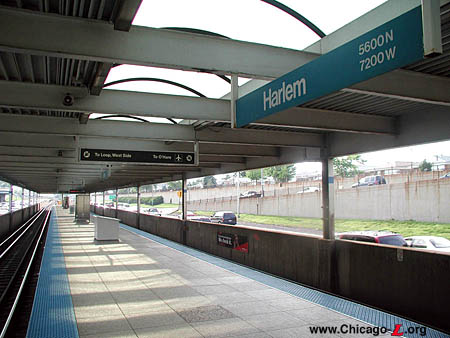
The Harlem island platform,
looking west on June 8, 2004, has convex arched skylights
providing natural light on the platform. The supports placed
outside the tracks provide a column-free platform. For a
larger view, click here.
(Photo by Graham Garfield)
|

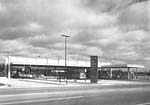
|
harlem01.jpg
(122k)
The entrance to the bus bay, park'n'ride, and kiss'n'ride
drop-off area for Harlem station are off Higgins Avenue,
seen here looking northeast in 1985, only two years after
opening. The triangular identification pylon in front of the
entrance is typical of the stations on the O'Hare
Extension. (Photo by
Hedrich-Blessing)
|
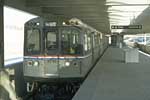
|
cta2710.jpg
(95k)
Newly-delivered 2600-series
car 2710, replete with its mint Spirit of Chicago paint
scheme and matching destination sign, is at Harlem station
on February 26, 1983, one day before the start of service on
the River Road extension of the
West-Northwest Route. (Photo by Jeff
Obarek)
|
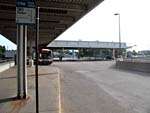
|
harlem04.jpg
(133k)
There are bus berthing slips on the bus bridge over the
expressway in front of the station entrance, as well as a
five-lane bus bay on the south side of the expressway with a
wide canopy covering the lanes, as seen looking south from
the station house on June 8, 2004. The canopy extends from
in front of the station over bus bridge sidewalk to the bus
bay, allowing passengers to transfer without stepping out
from the canopy coverage. (Photo by Graham
Garfield)
|

|
harlem07.jpg (213k)
Workers set rebar ahead of the concrete pour to form the base structure of a new platform edge for the northbound side of the Harlem station platform, looking east on September 11, 2016. (CTA photo) |
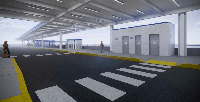
|
harlem_20240200_renderingbridge2.png (479k)
Rendering of the new bus terminal and bridge that will be constructed at the Harlem Blue Line station, looking northeast in the bus terminal. The station house and bridge over the expressway are on the left. (Image courtesy of the CTA) |

- harlem.wav
(18K): Conductor announcement for the next stop, Harlem.
Notes:
1. "CTA Announces $19.6M Project to Reconstruct the Bus Bridge at the Harlem Blue Line Transit Facility." CTA press release, February 14, 2024.
2. Jakubowski, Cyryl. "Bus terminal work at Harlem CTA Blue Line station to begin next week." Nadig Newspapers, February 14, 2024..
3. CTA press release, ibid.
4. Ibid.













